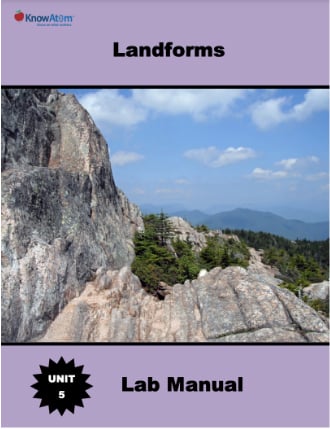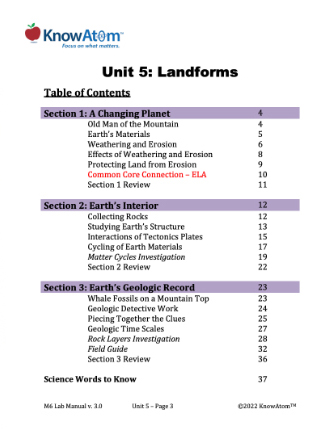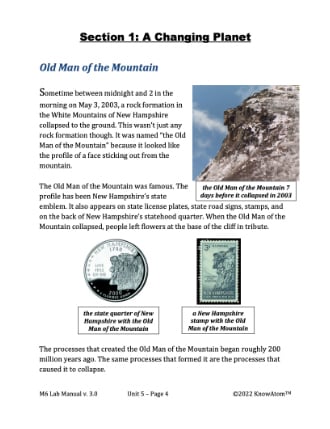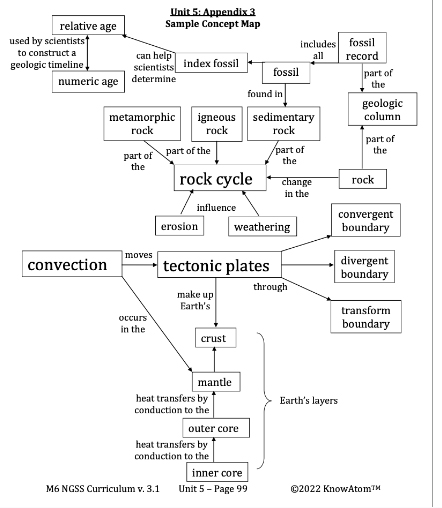Old Man of the Mountain
Sometime between midnight and 2am in the morning on May 3, 2003, a rock formation in the White Mountains of New Hampshire collapsed to the ground. This wasn’t just any rock formation though. It was named “the Old Man of the Mountain” because it looked like the profile of a face sticking out from the mountain.
The Old Man of the Mountain was famous. The profile has been New Hampshire’s state emblem. It also appears on state license plates, state road signs, stamps, and on the back of New Hampshire’s statehood quarter. When the Old Man of the Mountain collapsed, people left flowers at the base of the cliff in tribute.
The processes that created the Old Man of the Mountain began roughly 200 million years ago. The same processes that formed it are the processes that caused it to collapse.
Earth’s Materials
Understanding what caused the creation and collapse of the Old Man of the Mountain begins with an understanding of the materials that make up Earth’s surface.
Earth is a rocky planet. A rock is a mixture of minerals that heat and pressure have pressed together. Minerals are inorganic solids that form naturally from elements and compounds. About 70 percent of Earth’s surface is covered with water. The remaining 30 percent is covered by the continents. However, beneath the water and the layer of soil, sand, and plants is a rocky layer called Earth’s crust.
The study of Earth’s materials, as well as the processes that have shaped the planet, is called geology. The primary focus for geologists is the geosphere, and how the other systems interact with it. Remember that the geosphere is the Earth system that is made up of Earth’s solid materials, including its interior and surface features, such as landforms including mountains, valleys, rocks, and soil.
Weathering and Erosion
The geosphere doesn’t remain the same. Earth’s surface has been changing since Earth first formed 4.6 billion years ago, and it continues to change today. The rocks that geologists look at today are made of the same matter that existed when Earth first formed billions of years ago. Energy, both from the sun and Earth’s interior, work to constantly reshape and re-form all of the rocks on the planet. We’ll explore the changes caused by energy in Earth’s interior in the next section.
All rocks on Earth’s surface are constantly shaped by two processes: weathering and erosion. Weathering is the breakdown of rock into smaller pieces from exposure to wind, water, changes in temperature, and/or biological forces. You may have a difficult time imagining something solid like rocks wearing down over time, but everything does. If you take a look in the lint trap of your dryer, you will see that your clothes are being worn away as they tumble in the dryer. A dryer weathers your clothes. Pebbles on the beach are worn smooth by the action of waves and water.
Weathering is the result of interactions among all of Earth’s systems. For example, remember that when water falls to Earth’s surface as rain, it is slightly acidic because it carries some carbon dioxide from the atmosphere. This slightly acidic water causes chemical weathering of the rocks on Earth’s surface. Chemical weathering occurs when chemical reactions break down the bonds holding the rocks together. The chemical weathering breaks down the rocks, transforming the matter into new substances with different properties, including salt and other minerals. This is the process that causes salt and other substances to end up in the oceans, making salt water.
Wind and water also cause mechanical weathering. Mechanical weathering takes place when rocks are torn apart by physical force without any change in their chemical nature. In other words, the rock is physically broken down into smaller fragments, all of which keep the same properties as the original rock. The constant freezing and thawing of water in the water cycle is one of the most common types of mechanical weathering. During the cold months, the water expands into ice when it freezes. The expansion of the ice puts force on the rock and weathers it by deepening cracks. This is an interaction between the geosphere and the hydrosphere. Tree roots and insects can also cause mechanical weathering, making their way into rocks and causing them to slowly crumble away. These are interactions between the geosphere and the biosphere.
Effects of Weathering and Erosion
Weathering and erosion have shaped many of the landforms on Earth today. The destructive side of erosion carved out Earth’s valleys and canyons, while the deposits created the wetlands and river deltas. Weathering and erosion are also responsible for the creation and collapse of the Old Man of the Mountain.
The Old Man of the Mountain was created millions of years ago by weathering and erosion caused by the powerful movement of glaciers. A glacier is a flowing mass of ice and snow that forms on mountaintops and near the North and South poles. Glaciers weather and erode Earth materials as they move over them. Weathered Earth materials become frozen to the bottom of the glacier and get carried along with it. Those pieces of sediment get dragged over the land, weathering the land in the same way that sandpaper wears down and smoothes objects. As glaciers erode Earth materials, they carve out the land beneath them. These processes are what caused the rock formation in New Hampshire to appear to be the profile of a face.
Over the millions of years since the Old Man of the Mountain was created, weathering and erosion continued to work on the rocks, gradually weakening the structure. This constant wearing away and eroding eventually caused the rock formation to collapse in 2003. As the Old Man of the Mountain demonstrates, weathering and erosion can take place quickly or slowly.








